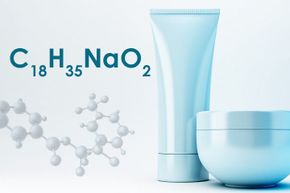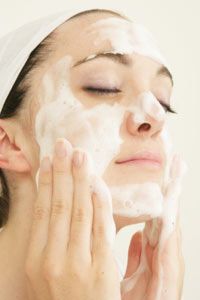When it comes to choosing a skin cleanser, most people are content to buy products that make their skin look and smell good. Some also select products to treat cellulite, fight blemishes or treat wrinkles -- for them, the ingredients in the cleanser don't matter as much as the promise of what it can do. But understanding the functions of the various substances in your cleansers can actually help you find the best ones to meet your skin care needs.
Sodium stearate, for example, is an ingredient that plays a key role in some skin cleansers. It's produced by combining stearic acid with lye; like most soaps, it consists of both fat and an alkali. Sodium stearate is a type of surfactant, which is an agent that basically makes it easier for water to get grime off of your skin. Surfactants are made up of two parts -- one part (the hydrophilic side) attracts water, while the other part (the hydrophobic side) repels it. As you wash your skin, the hydrophobic side of the surfactant clings to oil and dirt at the same time that the hydrophilic side attracts water, allowing the debris to rinse off [source: Marshall Cavendish Corporation]. Sodium soaps usually feel hard to the touch, even though they dissolve easily in water [source: Holman].
Advertisement
Sodium stearate is not the only ingredient used in soaps. Over the years, soap manufacturers have gradually added fragrances, moisturizers and dyes to the mix. Moreover, sodium stearate is not the only surfactant out there. It is, however, a rather mild surfactant and is less likely to cause irritation than some others [source: eMedicine].
Even though it's difficult to decide between types of skin cleansers, familiarizing yourself with the ingredients they contain can help you choose the best products for your particular skin type. For more information on skin care, read on to the following page.
Advertisement


